Papers by Fernando Acevedo
Electronic Journal of Biotechnology, 2014
Journal of Fermentation Technology, Feb 25, 1981
Critical Reviews in Biotechnology, 1987
Mass balancing: An effective tool for fermentation process optimization. F Acevedo CRC CRIT. REV.... more Mass balancing: An effective tool for fermentation process optimization. F Acevedo CRC CRIT. REV. BIOTECHNOL. 6:44, 309-322, 1987. The production of microbial metabolites is known to be determined by genetic and environmental ...
... to be incorporated into the plant genome: (1) infection with Agrobacterium tumefaciens (Gelvi... more ... to be incorporated into the plant genome: (1) infection with Agrobacterium tumefaciens (Gelvin, 2003), (2) electroporation (Trezise, 2002) and (3 ... BUSTAMANTE, JO An inexpensive inverted microscope for patch-clamp and other electrophysiological studies at the cellular level. ...
Hydrometallurgy, 2009
The interest in bioleaching as an alternative to the traditional pyrometallurgical technologies i... more The interest in bioleaching as an alternative to the traditional pyrometallurgical technologies is continuously increasing. In order to have an efficient biooxidation process some important limitations must be overcome, such as cell adaptation, gas transport phenomena, maximal ...
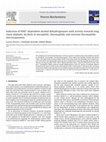
The production of alcohol dehydrogenases with the capacity of oxidizing long chain aliphatic alco... more The production of alcohol dehydrogenases with the capacity of oxidizing long chain aliphatic alcohols by mesophilic, thermophilic and hyperthermophilic strains induced by aliphatic alcohols and alkanes with 2-24 carbon atoms has been studied. Seven strains were tested: the mesophilic yeast Candida tropicalis ATCC20336, the thermophilic bacterium Thermus AB1and five hyperthermophilic bacterial strains: Thermus thermophilus HB27, HNI11, NR17, PRQ16 and PRQ25. Only C. tropicalis ATCC20336, Thermus AB1 and T. thermophilus PRQ25 produced alcohol dehydrogenases with the capacity of oxidizing aliphatic alcohols with 22 and 24 carbon atoms, after induction with 1-hexacosanol, 1-docosanol and 1-eicosanol, respectively. Higher initial reaction rates of oxidation of docosanol and eicosanol were obtained with the enzyme from C. tropicalis ATCC20336, with values of 196.9 and 218.8 mol NADH min −1 g of protein −1 , respectively.
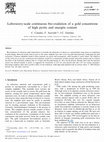
Process Biochemistry, 2002
Bio-oxidation of refractory gold concentrates is currently the alternative of choice as a pretrea... more Bio-oxidation of refractory gold concentrates is currently the alternative of choice as a pretreatment stage prior to cyanidation in gold mining. Bacterial attack removes part or the entire sulphide layer that covers the gold microparticles, facilitating the gold extraction. Common sulphides found in these minerals are pyrite and arsenopyrite, while enargite is rarely found. The objective of this work was to set up a continuous bio-oxidation system for a concentrate of high enargite and pyrite content and to evaluate the effect of the hydraulic residence time (3-8 days) and the pulp density (6 -24%) on the process. Results show that the bacterial attack was directed mainly to pyrite as suggested by extractions of 32% for iron (pyrite) and only 2.4% for arsenic (enargite). Increasing residence times had a positive effect on bio-oxidation, while high pulp densities had an adverse effect.
Trends in Biotechnology, 1985
Microbial leaching processes are being considered as an economical and technically viable alterna... more Microbial leaching processes are being considered as an economical and technically viable alternative for processing low-grade ores and wastes in developing countries. The research and development programs in developing countries aim to design appropriate ...
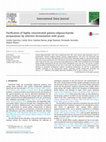
International Dairy Journal, 2014
Galacto-oligosaccharides (GOS) were synthesised from 50% (w/w) lactose with Aspergillus oryzae bg... more Galacto-oligosaccharides (GOS) were synthesised from 50% (w/w) lactose with Aspergillus oryzae bgalactosidase. Reacted medium without nutrient supplementation (raw GOS) was fermented with Kluyveromyces marxianus cells obtaining GOS of 95% purity containing mostly tri-and tetrasaccharides with total recovery of GOS after 24 h. The effect of the initial concentration of carbohydrate was assessed in the range of 10e50% (w/w), such purity being obtained even at 50% (w/w) (undiluted raw GOS) though being strongly influenced by the dry cell to total carbohydrate mass ratio (R CC ). The process of purification by selective fermentation of raw GOS at 20% (w/w) was optimised in terms of the specific productivity of unwanted carbohydrate removal, considering temperature, pH and R CC as operational variables. According to the experimental design, maximum specific productivity predicted was 0.16 g g À1 h À1 , obtained at the optimal operating conditions of 40 C, pH 3.5 and R CC 1.55 g g À1 .
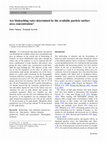
World Journal of Microbiology and Biotechnology, 2009
It is well known that pulp density and particle size determine the available surface area concent... more It is well known that pulp density and particle size determine the available surface area concentration and have an influence in the overall rate of bioleaching of minerals. As metal solubilization takes place through the surface area of the particles, it can be expected that different combinations of pulp densities and particle sizes giving the same surface area concentration would determine the same leaching rate. The objective of this work was to test this hypothesis on the effect of surface area concentration, pulp density and particle size of the biooxidation of a pyritic gold concentrate by the thermophilic Archaeon Sulfolobus metallicus in shake flasks. The gold concentrate was used at 2.5%, 5%, 10%, and 15% w/v pulp density and at four size fractions: 150-106, 106-75, 75-38 and -38 lm. Temperature was 68°C and the initial pH was 2.0. Results showed that the volumetric productivities of iron and sulfate depend not only on the surface area concentration but also on pulp density and particle size considered separately. These two variables not only determine surface area but also exert additional effects on the process, so the hypothesis was not confirmed. Maximum attained iron productivity was 1.042 g/l day with the 75-38 lm fraction at 5% pulp density. Maximum sulfate productivity was 4.279 g/l day with the 75-38 lm fraction at 10% pulp density.
Journal of Food Science, 1971
Journal of Biotechnology, 2008
C. Astudillo).
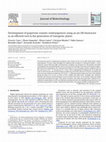
Journal of Biotechnology, 2009
The grapevine genetic transformation programs have relayed on the use of solid media-based somati... more The grapevine genetic transformation programs have relayed on the use of solid media-based somatic embryogenesis. To reach a high throughput of candidate gene evaluation in 'Thompson Seedless', a semiautomatic system allowing viable transformation of explants was designed. An intermediate procedure using liquid media and agitated flasks was first characterized, leading to reduction in the biomass duplication time of pro-embryogenic (PE) cells from 30 d in dishes to 14 d. The oxygen transfer coefficient value in this system was 213 h −1 at 120 rpm and 25 • C with a 16/8-h (light/darkness) photoperiod. The scaling-up to the air-lift bioreactor decreased the biomass duplication time of PE cells up to 5.3 d post-inoculation (pi) and an average volumetric productivity of 1.6 g/(d × L). Although slight browning was seen in the explants during the phase of 8-14 d pi, no losses in their viability and regenerative capability were observed. Cultured cells showed normal elongation in the transition from heart-to the torpedo-shape and finally to advanced developmental stages, with radicle emergence and whole plant generation. Agrobacteriummediated transformation of cells was efficiently incorporated after this multiplication process by use of conventional procedures in dishes, allowing the generation of transgenic plantlets confirmed by PCR.
Electronic Journal of Biotechnology, 2013
Bioleaching of minerals is a process that allows the treatment of insoluble sulphides and insolub... more Bioleaching of minerals is a process that allows the treatment of insoluble sulphides and insoluble oxides via hydrometallurgy, as opposed to the more traditional technology of pyrometallurgy. Bioleaching presents several technological, environmental and economic advantages as compared with pyrometallurgy, as well as some limitations. Results: In this work a general panorama of copper mining and biomining, the influence of the most relevant operating variables and their present and future situation in Chile are presented and discussed. Conclusions: Today, Chile plays an important role in the development and commercial application of bioleaching to copper ores. This background information allows predicting a brilliant future for this technology in Chile, as has been forecasted in the last years.
Electronic Journal of Biotechnology, 2000
Financial support: FONDECYT Grants 1980338 and 1000284 UCV Projects 203.703/98 and 203.715/00.
Electronic Journal of Biotechnology, 2002
Nowadays bioleaching occupies an increasingly important place among the available mining technolo... more Nowadays bioleaching occupies an increasingly important place among the available mining technologies. Today bioleaching is no longer a promising technology but an actual economical alternative for treating specific mineral ores. An important number of the current large-scale bioleaching operations are located in developing countries. This situation is determined by the fact that several developing countries have significant mineral reserves and by the characteristics of bioleaching that makes this technique especially suitable for developing countries because of its simplicity and low capital cost requirement.
Electronic Journal of Biotechnology, 2003
Financial support: FONDECYT 1980335 and DGIP-UCV 203.780. One of them (RG) received a AGCI fellow... more Financial support: FONDECYT 1980335 and DGIP-UCV 203.780. One of them (RG) received a AGCI fellowship from the Chilean government.
Bioresource Technology, 2010
Alginate production by Azotobacter vinelandii in chemostat cultures was evaluated at different di... more Alginate production by Azotobacter vinelandii in chemostat cultures was evaluated at different dilution rates (D) and inlet sucrose concentrations of 5 and 20 g l À1 . At the low inlet sucrose concentration, the molecular weight of alginate increased from 800 to 1800 kDa when D increased from 0.05 to 0.10 h À1 , whereas the opposite trend was observed with the high inlet sucrose concentration. This behaviour can be explained by changes in specific sucrose uptake rate. Thus, a decrease in alginate molecular weight was dependent on the specific sucrose uptake rate when this rate was higher than 0.42 g g À1 h À1 . The manipulation of the D can be used to select the molecular weight of alginate in continuous culture.
Bioprocess Engineering, 1999
In the scale-up of bioreactors one of the most commonly used criteria for aerobic processes is to... more In the scale-up of bioreactors one of the most commonly used criteria for aerobic processes is to keep the oxygen transfer coef®cient constant. Nevertheless, the reproduction of the behaviour of a cell population at different scales is not dependent just on the oxygen transfer capability but rather on the oxygen transfer rate, that must be high enough to cope with the oxygen demand of the culture. In this work a strategy of scaleup is proposed based in geometric similarity, constant impeller tip speed, and constant oxygen transfer rate. The effects of the dissolved oxygen concentration, the scale-up ratio and the rheology of the broth are analysed.

Uploads
Papers by Fernando Acevedo